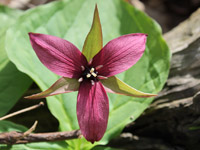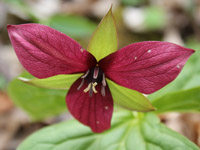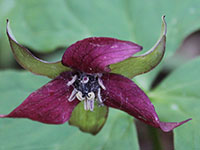![]()
Purple Trillium is a species of trillium in the lily family. Purple Trillium is native to eastern Canada and the Eastern United States. Purple Trillium is a spring ephemeral, an herbaceous perennial whose life-cycle is synchronised with that of the deciduous forests where it lives. The genus name comes from the Latin word trilix, which translates to 'triple', a reference to the three sepals and petals of the flower. The species name erectum refers to the erect flower stems. The plant takes its common name "wake-robin" by analogy with the European robin, a bird which has a red breast and is known as a bird which heralds spring.
![]()
Purple Trillium is grown as an ordamental garden plant.
![]() Within the realm of rational and holistic medicine, Purple Trillium was traditionally used by various native North American Indian tribes as a woman's herb to aid childbirth, as a treatment for irregular menstrual periods, period pains and excessive vaginal discharge. Modern research has shown that the root contains steroidal saponins, which have hormonal effects on the body. These saponins are being tested for use in gynaecological and obstetric medicine. This herb should not be taken during pregnancy except under professional supervision. The root is antiseptic, aphrodisiac, astringent, expectorant, tonic, uterine tonic It is used internally in the treatment of a wide range of women's complaints including haemorrhage from the uterus, urinary tract and lungs, and also to curb excessive menstruation. Purple Trillium has proved to be of value in stopping bleeding after parturition. Externally, it is used to treat excessive vaginal discharge, ulcers (especially varicose), skin complaints, gangrene, insect bites and stings. It is also used as a wash for sore nipples. The root is harvested in late summer, after the leaves have died down, and is dried for later use. The whole plant is used as a poultice for tumours, inflammations and ulcers.
Within the realm of rational and holistic medicine, Purple Trillium was traditionally used by various native North American Indian tribes as a woman's herb to aid childbirth, as a treatment for irregular menstrual periods, period pains and excessive vaginal discharge. Modern research has shown that the root contains steroidal saponins, which have hormonal effects on the body. These saponins are being tested for use in gynaecological and obstetric medicine. This herb should not be taken during pregnancy except under professional supervision. The root is antiseptic, aphrodisiac, astringent, expectorant, tonic, uterine tonic It is used internally in the treatment of a wide range of women's complaints including haemorrhage from the uterus, urinary tract and lungs, and also to curb excessive menstruation. Purple Trillium has proved to be of value in stopping bleeding after parturition. Externally, it is used to treat excessive vaginal discharge, ulcers (especially varicose), skin complaints, gangrene, insect bites and stings. It is also used as a wash for sore nipples. The root is harvested in late summer, after the leaves have died down, and is dried for later use. The whole plant is used as a poultice for tumours, inflammations and ulcers.
Please note that MIROFOSS does not suggest in any way that plants should be used in place of proper medical and psychological care. This information is provided here as a reference only.
![]()
The leaves contain calcium oxalate crystals and crystal raphide, and should not be consumed by humans. However, there are reports of the leaves being eaten; raw or cooked. the young unfolding leaves have been used as an addition to salads, tasting somewhat like sunflower seeds. Leaves can also be cooked as a potherb.
![]()
Purple trillium is a slow growing perennial which is suitable for: light (sandy), medium (loamy) and heavy (clay) soils and prefers well-drained soil. Suitable pH: acid, neutral and basic (alkaline) soils. It can grow in full shade (deep woodland) semi-shade (light woodland) or no shade. It prefers moist soil.
| Soil Conditions | |
| Soil Moisture | |
| Sunlight | |
| Notes: |
![]()
Purple Trillium can grow to approxiamtely 40cm in height with a leaf spread of up to 30cm. Purple Trillium prefers to grow in cool, nutrient rich soil in deiduous forests; as well as along the boarders of swamps. Purple Trillium can tolerate extreme cold in winter, surviving temperatures down to −35 °C. Like all trilliums, its parts are in groups of three, with 3-petalled flowers above whorls of pointed triple leaves. The flowers are a deep red colour, though there is a white form. The flowers have the smell of rotting meat which attracts carrion flies, which act as pollinators. Each leaf is broadly diamond shaped 5cm to 20cm long and dark green in colour. After flowering, purple trillium contains a dark maroon, globe shaped berry; 10mm to 15mm long and juicy.
![]()
| Plant Height | 40cm | 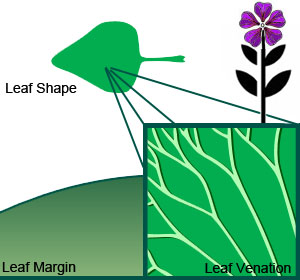 |
| Habitat | Moist rich woodlands | |
| Leaves | Deltoid | |
| Leaf Margin | Entire | |
| Leaf Venation | Dichotomus | |
| Stems | Smooth stems | |
| Flowering Season | April to June | |
| Flower Type | Radially Symmetrical | |
| Flower Colour | Violet-Red | |
| Pollination | Carrion Flies | |
| Flower Gender | Flowers are hermaphrodite and the plants are self-fertile | |
| Fruit | Long juicy berries containing seeds | |
| USDA Zone | 4A (-31°C to -34°C) cold weather limit |
![]()
The following health hazards should be noted when handling or choosing a location to plant purple trillium:
 |
TOXIC The leaves contain calcium oxalate crystals and crystal raphide, and should not be consumed by humans. |
![]()
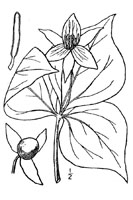 |
-Click here- or on the thumbnail image to see an artist rendering, from The United States Department of Agriculture, of purple trillium. (This image will open in a new browser tab) |
![]()
Purple Trillium can be referenced in certain current and historical texts under the following four names:
Purple Trillium can be translated into the following select languages:
| Arabic | الأرجواني، تريليوم | Bulgarian | Chinese (Sim) | 紫延龄 | |
| Croatian | Czech | Danish | |||
| Dutch | Esperanto | Estonian | |||
| Finnish | French | German | |||
| Greek | Μωβ άνθος | Hebrew | Hungarian | ||
| Italian | Japanese | パープルエンレイソウ | Korean | 퍼플 연령초 | |
| Punjabi | Lithuanian | Norwegian | |||
| Persian | تریلیوم بنفش | Polish | Portuguese | ||
| Romanian | Russian | Slovak | |||
| Spanish | Swedish | Tagalog | |||
| Turkish | Ukrainian | Vietnamese |

![]()
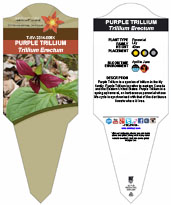 |
The MIROFOSS database offers free printable garden tags for personal and non-profit use. These tags can be used to properly identify plant samples in a garden. Click on the tags shown on the the screen or -click here- to download a full size jpeg image for a purple trillium identification tag; which can be printed on paper or used with a plastic laser printer. |
 |
What's this? What can I do with it? |
![]()
| Description | RHS A-Z encyclopedia of garden plants. United Kingdom: Dorling Kindersley. 2008. p. 1136. ISBN 1405332964. |
| Description | Flora of North America Editorial Committee. 2002a. Flora of North America North of Mexico. Vol. 26. Magnoliophyta: Liliidae: Liliales and Orchidales. Oxford Univ. Press, New York. xxvi + 723 pp. |
| Folklore | Robbins, C. 1999. Medicine from US wildlands: An assessment of native plant species harvested in the United States for medicinal use and trade and evaluation of the conservation and management implications. Traffic North America. Prepared for The Nature Conservancy, Arlington, VA |
| Description | Kartesz, J.T. 1994. A synonymized checklist of the vascular flora of the United States, Canada, and Greenland. 2nd edition. 2 vols. Timber Press, Portland, OR. |
| Biology | Dickinson, T.; Metsger, D.; Bull, J.; & Dickinson, R. (2004) ROM Field Guide to Wildflowers of Ontario. Toronto:Royal Ontario Museum, |
| Image Rendering | USDA-NRCS PLANTS Database / USDA NRCS. Wetland flora: Field office illustrated guide to plant species. USDA Natural Resources Conservation Service. |
| Environment | National Audubon Society. Field Guide To Wildflowers (Eastern Region): Alfred A. Knopf. ISBN 0-375-40232-2 |
| Physical Identification | National Audubon Society. Field Guide To Wildflowers (Eastern Region): Alfred A. Knopf. ISBN 0-375-40232-2 |
| April 15, 2017 | The last time this page was updated |
| ©2021 MIROFOSS™ Foundation | |
 |
|

